For many watch enthusiasts, winding a mechanical watch is more than just a daily ritual—it’s a way to connect with a time-honored tradition. Mechanical watches, whether manual or automatic, require winding to maintain their accuracy and reliability. However, improper winding can lead to damage that is both costly and preventable. To get the most out of your timepiece, it’s essential to know how to properly wind your watch without compromising its delicate mechanics. In this guide, we’ll explore how to wind different types of watches and discuss best practices that help avoid unnecessary damage.
Understanding the Types of Mechanical Watches
Before diving into the process of winding, it’s crucial to understand the difference between manual and automatic mechanical watches. Manual watches require the wearer to wind the crown to store energy in the mainspring, while automatic watches feature a rotor that winds the mainspring using the movement of the wearer’s wrist. Despite these differences, both types have winding mechanisms that need to be treated with care.
Manual watches need to be wound regularly, ideally at the same time each day, to maintain optimal accuracy. Automatic watches, on the other hand, are designed to keep running with regular wear. However, if they are not worn for extended periods, they will also require manual winding to get them started again. Understanding these basics is key to ensuring that you wind your watch correctly without causing wear or damage to the movement.
Proper Techniques for Winding a Manual Watch
When winding a manual watch, it’s important to follow a few simple steps to avoid damaging the delicate inner workings. The crown—the small knob on the side of the watch—is where all the action takes place. Here are the best practices for winding a manual watch:
- Remove the Watch from Your Wrist: Always take your watch off your wrist before winding it. Winding your watch while it’s still on your wrist can put undue pressure on the winding stem and potentially bend or damage it. By removing the watch, you also ensure that you are winding in a straight motion, reducing the risk of mechanical strain.
- Wind Slowly and Steadily: Grasp the crown between your thumb and forefinger and turn it in a clockwise direction. You should feel a slight resistance as the mainspring tightens. It’s important to wind slowly and evenly, without rushing, to avoid slipping or over-tightening the crown.
- Know When to Stop: One of the most critical aspects of winding a manual watch is knowing when to stop. As you wind, you will notice that the crown becomes harder to turn. This indicates that the mainspring is fully wound. Forcing the crown beyond this point can cause damage to the mainspring, resulting in costly repairs. The goal is to wind until you feel resistance and then stop—there’s no need to push beyond this limit.
Winding an Automatic Watch
Automatic watches are designed to wind themselves through the motion of the wearer’s arm, but they can also be wound manually if needed. This is especially useful if the watch has stopped after not being worn for a while. While automatic watches have a mechanism that prevents overwinding, it’s still essential to wind them properly to maintain the health of the movement.
- Start with Gentle Turns: To manually wind an automatic watch, locate the crown and turn it clockwise about 20 to 30 times. This is usually enough to get the movement started. Unlike manual watches, you don’t need to wind until full resistance is felt. Instead, a few gentle turns will suffice.
- Avoid Overwinding: Most modern automatic watches have an overwind protection mechanism, but it’s still good practice to avoid excessive winding. Too much force can still damage internal components, particularly if the watch is older or lacks a sophisticated overwind protection system.
- Shake Gently for Power Reserve: If your automatic watch has completely stopped, you can also gently rock the watch side to side to move the rotor and give the mainspring a small amount of energy. This can be particularly helpful if you don’t have time to manually wind it or if the crown is difficult to operate.
Avoiding Common Mistakes While Winding
Winding a watch may seem like a straightforward task, but there are a few common mistakes that can lead to issues if not avoided. Here are some pitfalls to watch out for:
- Overwinding the Mainspring: One of the most common mistakes is overwinding a manual watch. As mentioned earlier, it’s essential to stop winding as soon as you feel resistance. Overwinding can result in a broken mainspring, requiring a complete overhaul of the movement.
- Winding at the Wrong Time: For watches with complications, such as date or moonphase functions, avoid winding or adjusting the watch between 9 PM and 3 AM. During this period, the gears that control the date mechanism are engaged, and changing the time or winding can cause these components to become misaligned or damaged. It’s best to wait until mid-morning to make any adjustments.
- Using Excessive Force: Delicate internal parts mean that using excessive force while winding can lead to bent or broken components. Always wind gently and stop if you feel any abnormal resistance or grinding.
- Neglecting Regular Maintenance: Mechanical watches are intricate machines that require regular servicing. Dust, dirt, and lubrication issues can all affect the winding mechanism. If you notice difficulty winding or if the watch stops holding power, it’s time to take it to a professional watchmaker for inspection and maintenance.
Best Practices for Maintaining Your Watch’s Health
In addition to proper winding techniques, there are several other best practices you can follow to keep your watch in great condition:
- Keep It Clean: Dust and dirt can accumulate around the crown, making it harder to wind and potentially causing wear on the gaskets. Use a soft cloth to gently clean the crown and case of your watch, and avoid exposing your watch to extreme environments.
- Store It Correctly: When you’re not wearing your watch, store it in a dry place away from extreme temperatures and magnetic fields. For automatic watches, a watch winder can be a useful accessory, keeping your watch wound and ready to wear without overwinding.
- Regular Servicing: Mechanical watches should be serviced every 3 to 5 years to keep them running smoothly. During servicing, the watchmaker will clean and lubricate the movement, ensuring that all components—including the winding mechanism—are in good working order.
Signs That Your Watch Needs Professional Attention
Even with the best winding practices, there may come a time when your watch needs professional care. Here are a few signs that indicate it’s time to see a watchmaker:
- Difficulty Winding: If the crown is stiff, grinding, or unusually loose, this could indicate a problem with the winding stem or mainspring.
- Inconsistent Timekeeping: If your watch is losing or gaining significant time, it may be due to a problem with the mainspring or the movement. Proper winding should result in consistent timekeeping, and if that’s not happening, a professional inspection is warranted.
- Unusual Sounds: Mechanical watches generally have a gentle ticking sound, but grinding or clicking while winding can indicate something is wrong internally.
Final Thoughts on Winding Your Watch
Properly winding your mechanical watch is a simple yet important part of keeping it in good working condition. Whether you have a manual or automatic timepiece, following best practices will help prevent damage, extend its lifespan, and ensure that it remains a reliable companion for years to come. With the right care and attention, winding your watch can become a satisfying ritual that connects you to the craftsmanship and tradition of horology.






